Jon Reed's Blog, page 10
May 20, 2016
Do I really need an editor for my self-published book?
This article first appeared in issue 7 of Publishing Talk Magazine.
Some self-published writers think it’s fine to scrimp on editing, but the truth is that every book needs to be edited and proofread, says Lucy Ridout.
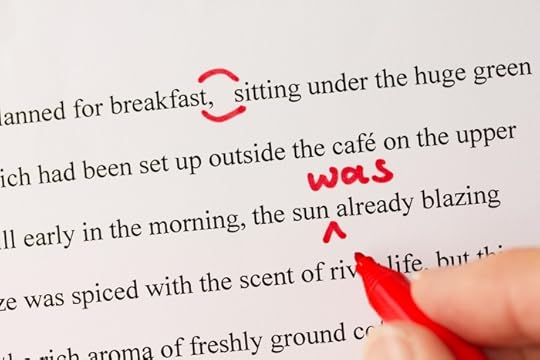
Writers with a trade-publishing deal get automatic access to professional editors and proofreaders, but self-publishers have to source their own. Some writers think it’s fine to scrimp on this, but the truth is that every book needs to be edited and proofread. Readers loathe wading through garbled grammar, typos and badly formatted text and online reviewers are never slow to point this out.
Hiring editorial assistance will increase your costs and some writers may struggle to recoup that investment. But if you care about your reputation as an author, you’ll almost certainly want to bring in the experts and give your book a professional polish.
Structural editing
A structural (or substantive) edit happens when you’ve completed your first draft and are ready for a second opinion. It is primarily concerned with big-picture issues. Is the pace maintained or could some chapters be condensed and others fleshed out? Are the chapters in the right order? Are locations and characters credible and distinctive? Is the narrative voice consistent and engaging?
Your editor will analyse these and many other issues in detailed editorial notes and will also suggest ways in which improvements might be made. It’s up to you, of course, whether or not you act on their suggestions, but it’s worth remembering that your editor is working for you and will have your best interests at heart.
Copy-editing
The copy-edit comes after the structural revisions have been completed. Here the editor focuses on the nitty-gritty of the language and on accuracy, consistency and clarity. Typos get eliminated, punctuation corrected and inconsistencies smoothed. Clichés and idiosyncratic tics are highlighted and factual errors identified. It’s where the professional gloss gets applied, transforming an amateur-looking manuscript into a book that can hold its own in any bookshop.
Your copy-editor will compile a style sheet and word list noting the language points particular to your book. Have you used ‘recognise’ or ‘recognize’? Words or digits for numbers over ‘ten’? Are characters’ thoughts styled in italics or plain text? These lists become the style manual for your proofreader.
The copy-editor will also prepare the text for the typesetter or formatter, making sure that standard publishing conventions are followed regarding paragraph indents, heading hierarchies, dialogue and so forth.
Proofreading
A proofreader is the last person to go through the book before it gets published. They check for any lingering mistakes, using the copy-editor’s style manual for a final once-over. They also ensure that the layout is clean, with running heads and page numbers in place, chapter heads aligned and superfluous paragraph returns eliminated.
Can’t my literate aunt do the edit?
Any literate friend should be able to spot spelling mistakes and grammatical errors. But it takes someone with a professional publishing background to apply the quality sheen your book will need if it’s to compete with the thousands of other books produced by high-spending publishing houses.
Top tips for hiring an editor
Start early. Many freelance editors are booked up a long way ahead. To maximise your choice, begin your search at least three months before you’re ready to get going.
Be choosy. Browse the directories of reputable organisations such as the Society for Editors and Proofreaders (www.sfep.org.uk/directory/directory.asp) and the Publishing Training Centre (www.train4publishing.co.uk/freelance-...), check credentials and don’t be shy about contacting several editors simultaneously.
Provide some background information. When contacting prospective editors, tell them what genre your book is and give them a plot summary and word count. Mention relevant writing experience and any particular help you’re looking for. You should also send them a couple of sample chapters.
Ask for a sample edit. Some editors offer this for free on extracts of up to 2000 words, others will ask for a nominal fee.
Listen to your instinct. Sharing your precious text with a stranger is a brave thing to do so you need to have confidence in the editor you choose. You should get a reasonable sense of this from any email exchanges you have, and from the sample edit.
Polish until you can polish no more. Submit your manuscript for editing only when it’s as perfect as you can make it. It’s uneconomical to give an editor a script full of lazy, rudimentary errors. Their time is best spent alerting you to infelicities you didn’t know were there.
Enjoy the attention. Relish the opportunity to discuss your book in intensive detail with your editor. They probably know your text better than anyone else.
Take a deep breath. Expect to be at first shocked by the number of issues your editor has spotted, and then grateful. Every writer has blind spots about their own work. The editor’s job is to highlight them, save you from potential embarrassment and help you shine.
This article was commissioned by The Publishing Training Centre, the only not-for-profit organisation in the UK solely focused on delivering training courses for the publishing industry and developing publishing skills. Find out more at www.train4publishing.co.uk.


Do I really need an editor?
This article first appeared in issue 7 of Publishing Talk Magazine.
Some self-published writers think it’s fine to scrimp on editing, but the truth is that every book needs to be edited and proofread, says Lucy Ridout.

Writers with a trade-publishing deal get automatic access to professional editors and proofreaders, but self-publishers have to source their own. Some writers think it’s fine to scrimp on this, but the truth is that every book needs to be edited and proofread. Readers loathe wading through garbled grammar, typos and badly formatted text and online reviewers are never slow to point this out.
Hiring editorial assistance will increase your costs and some writers may struggle to recoup that investment. But if you care about your reputation as an author, you’ll almost certainly want to bring in the experts and give your book a professional polish.
Structural editing
A structural (or substantive) edit happens when you’ve completed your first draft and are ready for a second opinion. It is primarily concerned with big-picture issues. Is the pace maintained or could some chapters be condensed and others fleshed out? Are the chapters in the right order? Are locations and characters credible and distinctive? Is the narrative voice consistent and engaging?
Your editor will analyse these and many other issues in detailed editorial notes and will also suggest ways in which improvements might be made. It’s up to you, of course, whether or not you act on their suggestions, but it’s worth remembering that your editor is working for you and will have your best interests at heart.
Copy-editing
The copy-edit comes after the structural revisions have been completed. Here the editor focuses on the nitty-gritty of the language and on accuracy, consistency and clarity. Typos get eliminated, punctuation corrected and inconsistencies smoothed. Clichés and idiosyncratic tics are highlighted and factual errors identified. It’s where the professional gloss gets applied, transforming an amateur-looking manuscript into a book that can hold its own in any bookshop.
Your copy-editor will compile a style sheet and word list noting the language points particular to your book. Have you used ‘recognise’ or ‘recognize’? Words or digits for numbers over ‘ten’? Are characters’ thoughts styled in italics or plain text? These lists become the style manual for your proofreader.
The copy-editor will also prepare the text for the typesetter or formatter, making sure that standard publishing conventions are followed regarding paragraph indents, heading hierarchies, dialogue and so forth.
Proofreading
A proofreader is the last person to go through the book before it gets published. They check for any lingering mistakes, using the copy-editor’s style manual for a final once-over. They also ensure that the layout is clean, with running heads and page numbers in place, chapter heads aligned and superfluous paragraph returns eliminated.
Can’t my literate aunt do the edit?
Any literate friend should be able to spot spelling mistakes and grammatical errors. But it takes someone with a professional publishing background to apply the quality sheen your book will need if it’s to compete with the thousands of other books produced by high-spending publishing houses.
Top tips for hiring an editor
Start early. Many freelance editors are booked up a long way ahead. To maximise your choice, begin your search at least three months before you’re ready to get going.
Be choosy. Browse the directories of reputable organisations such as the Society for Editors and Proofreaders (www.sfep.org.uk/directory/directory.asp) and the Publishing Training Centre (www.train4publishing.co.uk/freelance-...), check credentials and don’t be shy about contacting several editors simultaneously.
Provide some background information. When contacting prospective editors, tell them what genre your book is and give them a plot summary and word count. Mention relevant writing experience and any particular help you’re looking for. You should also send them a couple of sample chapters.
Ask for a sample edit. Some editors offer this for free on extracts of up to 2000 words, others will ask for a nominal fee.
Listen to your instinct. Sharing your precious text with a stranger is a brave thing to do so you need to have confidence in the editor you choose. You should get a reasonable sense of this from any email exchanges you have, and from the sample edit.
Polish until you can polish no more. Submit your manuscript for editing only when it’s as perfect as you can make it. It’s uneconomical to give an editor a script full of lazy, rudimentary errors. Their time is best spent alerting you to infelicities you didn’t know were there.
Enjoy the attention. Relish the opportunity to discuss your book in intensive detail with your editor. They probably know your text better than anyone else.
Take a deep breath. Expect to be at first shocked by the number of issues your editor has spotted, and then grateful. Every writer has blind spots about their own work. The editor’s job is to highlight them, save you from potential embarrassment and help you shine.
This article was commissioned by The Publishing Training Centre, the only not-for-profit organisation in the UK solely focused on delivering training courses for the publishing industry and developing publishing skills. Find out more at www.train4publishing.co.uk.


April 11, 2016
How to build an effective content strategy

Today the London Book Fair’s Quantum conference is in full swing (follow the action on Twitter with #quantum16). Last year, this conference was called Publishing for Digital Minds, and Jon Reed returned with a new mantra: everything is conetent and everything is marketing.
This article first appeared in issue 7 of Publishing Talk Magazine.
Building an Effective Content Strategy
For authors and publishers, content is our bread and butter. But content no longer just mean the products we publish – it also means marketing. So how do we build an effective content strategy? This question was addressed at the 2015 London Book Fair Publishing for Digital Minds Conference. The short answer is to focus on value rather than on selling. A longer answer was provided in three presentations in a session called ‘What does an Effective Content Strategy Look Like?’ chaired by Faber and Faber’s Matt Haslum.
Everything is Content and Everything is Marketing
Since they engage two million people with digital content per month, The British Film Institute (BFI) knows a thing or two about audience engagement. Their digital director, Ed Humphrey, described their goal as being to entertain and inspire audiences with film culture. His thesis is that, in order to engage audiences with cultural products or experiences (and yes, that includes books), everything is content and everything is marketing.
The BFI has a lot of free video content on their site, in the form of talks, interviews and trailers (http://www.bfi.org.uk/talks-interviews-trailers). Counterintuitively for many content marketing professionals, these often have no call to action. For example, you can watch a web series of 20-minute interviews, such as Sally Hawkins talking to Edith Bowman on “the films that made me.” So far as Humphrey is concerned, ‘If at the end of that you do nothing more than watch the series, that’s good enough. The payoff can come at a much later date.’
If it’s content only to create an outcome, its not really content. With a lot of content marketing, if you take the product away, the content doesn’t exist.
According to Humphrey, ‘If it’s content only to create an outcome, its not really content. With a lot of content marketing, if you take the product away, the content doesn’t exist.’ The content should stand up in its own right as something that your target audience finds useful and valuable.
This sounds a lot like that contemporary business model of audience-building with a view to later monetization – and the BFI does indeed have large audiences on Twitter (@BFI, with 380,000 followers) and Instagram (@britishfilminstitute, with 21,000 followers) – both social networks that lend themselves to visual content-sharing. Images work well for visual media such as film. For example, on 27th March 2015, @BFI tweeted: “Some films cling for a lifetime. One premiered on this day in 1970: Kes” along with a still image from the film Kes. This got over 300 retweets, and led to a conversation about whether the film should be re-released.
But think about what visual content you can use to promote books too. Images are essential for social media engagement today. In a session on ‘Successful Social Media Strategies’ for authors in the London Book Fair’s AuthorHQ strand later in the week, a member of the audience asked how she could engage her audience on social media. ‘Post images!’ came the resounding reply from the panel.
Quizzes are also a popular way to engage audiences. While Buzzfeed may release around 12 quizzes per day, when the BFI posts a quiz they have to make sure resonates with their audience as part of a fully-rounded experience. Making your content relevant to your audience is essential. Their ‘Are you a Replicant?’ quiz (www.bfi.org.uk/are-you-a-replicant) does have an outcome – they want people to see the film, and the quiz ends not only with ‘share your results on Twitter / Facebook’ buttons, but a link to ‘Find a screening of Blade Runner: The Final Cut near you.’
While not every piece of content may have such a direct call to action, there is marketing theory behind all of their content-sharing. Humphrey described how the BFI uses ‘personas’ in their marking planning, and how they use a lifecycle marketing approach to address their audience’s evolving needs over time. They aim to move ‘persona groups’ somewhere around a four-stage wheel (acquire -> retain -> convert -> share -> acquire etc.) with their content strategy.
Content Value
Sonja Jefferson of Valuable Content asked: ‘What is it that makes some content valuable and others fall flat?’ and outlined three key principles, with examples:
1. Help, Don’t Sell
Even banks can get this one right! HSBC’s @expatexplorer Twitter account provides unbelievably helpful content, driven by one simple question: What is it that people who move abroad need to know? Their content includes the Expat Explorer Survey – an annual survey about how you would rate the country you’re living in presented as an interactive tool on web, it attracted 200,000 views in the first six months with no advertising.
2. Show, Don’t Tell
Hiut Denim (@hiutdenim), with their mantra ‘Do One Thing Well’, prove they’re the best jeans in the world not by telling us, but through sharing customer stories. This is done with zero ad spend, and all through social media stories shared visually using HistoryTag. A unique code in every pair of hand-crafted pair of jeans is used to pull in pictures from Flickr and Instagram to a profile page on historytag.com, enabling the story of a pair of jeans to be told, from the manufacturer who signs their work to the first owner, to any subsequent owners.
3. Talk, Don’t Yell
This is a very different way of marketing. Many marketers have been trained that ‘he who shouts the loudest will win the customer’ – but successful marketing today is about having conversations, not shouting at people. The example offered here was the UK’s National Trust transforming its business to make the most of content opportunities. Broadcast doesn’t work for them any more, so they’re putting the people who have knowledge of the business – such as gardeners – in touch with people like you and me, by training their staff and entrusting them with content-sharing. ‘We’re talking to real people at the end of the line,’ said Jefferson, ‘acting like a good citizen will help you get results.’
Content Community
Daniel Houghton of Lonely Planet, the world’s largest travel guide publisher, spoke on building a content-led business model. When he started at LP, it was a books business – but it increasingly didn’t make sense only to have editors for books – so they now have ‘destination editors’ – each serving a region of the world, irrespective of product, with content thought through holistically in a multi-platform way. While there is a big focus on digital products, it has not been a complete shift, and the print side of the business is thriving, with new book series and magazines launching. In a shrinking market they’re selling more books and engaging more people on more platforms.
Social media and community is incredibly important for their business, and they think of content that can be sliced and diced and used in multiple contexts. As with the BFI, they can be found on platforms where images are key: They are one of the largest travel brands on Twitter (@lonelyplanet) with 2.4m followers; and have 261,000 followers on Instagram (@lonelyplanet). They are also early adopters of new social platforms, such as Meerkat and Periscope. This might sound counterintuitive since so few people use these at the moment – but early adopters can do well if these platforms take off, so don’t ignore them – they can be a great opportunity to reach people.
Content Curation
Repurposing and curation were also buzzwords of the day. Curating information has always been important to Lonely Planet – such as picking the ‘10 best places to eat in London.’ But curation is increasingly important to all of us, and the panel suggested that publishers have only just started thinking about how to package their content.
In his opening remarks, Faber’s Matt Haslum said: ‘relevant, useful, entertaining content that fits into our readers lives will be read and shared,’ but that we should think not only of the types of content that might be relevant to our business in terms of text, images or infographics, but whether this material is original or curated. ‘We don’t always have to create original content,’ he said, ‘readers want to know what we read or watch, not just what we create. And using content in new ways can create new revenue for authors.’
Humphrey said the BFI has hardly any IP – but it has the confidence to lead a conversation around film. Houghton pointed out that Airbnb doesn’t own any hotel rooms and it’s a great business!
Upworthy (www.upworthy.com) may be the fastest growing news site of all time – yet it doesn’t write news: it writes headlines. Their staff will re-write headlines 30 or 40 times until they start to drive traffic. ‘There’s an interesting truth in that idea,’ said Humphrey, ‘it’s not necessarily about creating new stuff – it can be about reinterpreting stuff we already have.’ While publishing may be fixated on the idea that we have to do it once and get it perfect, we can also republish. ‘New is good but great is great,’ said Humphrey, ‘we give new reasons to watch old films.’ And the BFI also makes frequent use of #ICYMI (‘in case you missed it’) – a popular web trope for retweeting.
Whether content is original or curated, text or image, free or paid for, product or marketing, quality and trust still matter most – and this is where publishers have an important role. ‘Stick to your editorial principles,’ says Houghton, ‘the most important thing we have is that people trust our brand.’
How to build an effective content strategy
Be generous – give content away generously; you don’t always need a ‘call to action’ or a hard sell. Focus on conversations rather than marketing messages, and ‘talk, don’t yell’
Offer value – make your free content valuable, something useful on its own merits. Think ‘help, don’t sell’, and create a great user experience.
Build community around your content using social media, and encourage your community tell your brand story – ‘show, don’t tell’
Post images – content isn’t just about text, and the highest click-through rates from social networks come from images and videos rather than status updates and links.
Curate and repurpose – think about curating, repurposing and sharing content, as well as simply owning it or creating it.


March 5, 2016
6 ways to overcome procrastination and beat writers’ block
This post first appeared on the Write-Track blog.
We all procrastinate – but you can overcome it with practical strategies. So stop putting off your dreams and reward your future self, says Bec Evans.

I’ve spent the last hour in an internet wormhole ‘researching’ procrastination. I made the usual excuse that it was necessary groundwork for this blog post but. to be honest, I was delaying the task at hand. The instant hit of clickbait was preferable to knuckling down and earning the satisfaction that comes from effort.
I’m not alone. We all procrastinate, often several times a day. Humans are hard wired to seek pleasure and, in this age of distraction, getting side tracked is the norm.
Postponing writing
Writers are the masters of procrastination – it’s far simpler to type a search term into Google than it is to write the first line of a novel. Whether you’re a full-time writer, a part-time scribbler, or a dreamer with ambitions to write, it’s all too easy to delay.
Dr Robert Boice, author of Procrastination and Blocking: A Novel Approach, spent two decades delving into the minds of writers to work out why they are so easily distracted. The people he studied wanted to write – for many it was a requirement of their job – but they put it off because there was something easier or more pleasurable to do.
Procrastinators chose alternative activities. He said they “opt for short-term relief through acts that are easy and immediately rewarding, while generally avoiding the thought (and anxiety) of doing more difficult, delayable, important things.” This focus on immediate pleasure side tracked people from their intention and prevented them from starting.
Procrastonators opt for short-term relief through acts that are easy and immediately rewarding – Robert Boice
But it’s not just about postponing. Boice found many writers get stuck in the middle, often when things get tricky, and this blocks their progress. He explained that this was because of: “paralyzing anxiety and uncertainty, often because the task will be evaluated publically.”
He called this second group ‘blockers’ and their fear stopped them making progress even though they might have already invested significant time and effort.
The procrastination mindset
Whether you’re a put-off-starting type or a stuck-in-the-middle writer there are certain characteristics that all procrastinators have in common. Boice found that both had an unrealistic belief that the work will get done – somehow. It’s as if saying you’ll pen a novel is enough.
There was also a disproportionate focus on the outcome, rather than the input required to make that dream come true. This caused increased levels of anxiety. Thinking about writing a whole book is understandably scary, whereas writing one word, one sentence, or one page is much less frightening. Finally, there was a tendency towards busyness and rushing as writers tried to compensate for the delay in starting.
The path to productivity – changing your mindset
Just because your procrastination can be defined doesn’t mean you are defined by it. There are simple tricks you can take to avoid distraction and delay to make progress towards your creative dreams.
“There has to be a change in mindset so your present self acts in the interest of your future self”
At heart all procrastinators value immediate rewards more highly than future rewards. There has to be a change in mindset so your present self – the one that wants immediate satisfaction – acts in the interest of your future self – the one who wants to complete a book. This means putting in place a system that rewards long-term activities and punishes the short-term distractions.
6 ways to overcome procrastination and blocking
1. Scheduling
Com mitting time to write is one of the best ways to avoid procrastination. There are lots of different approaches to finding time to write but essentially it all comes down to scheduling.
mitting time to write is one of the best ways to avoid procrastination. There are lots of different approaches to finding time to write but essentially it all comes down to scheduling.
Take your diary, find time that you can use for writing and make an appointment so you treat it like any other commitment. Start small – it could just be fifteen minutes a day – and build up from there. It’s important to get into the habit of sticking to a schedule.
Researchers have found the most productive schedule involves writing every day, for no longer than 90 minutes, with regular breaks and fixed end point. Developing a daily practice will take the effort and willpower out of deciding when to write.
2. Rewards
Giving you rself a treat when you’ve completed your task can help you avoid getting side-tracked. Rather than indulging yourself in a procrastination activity before you start, why not use it as a reward for when your writing is completed? Think of something small enough to encourage, but not too big that writing become all about the reward, and you’ll find your motivational sweet spot.
rself a treat when you’ve completed your task can help you avoid getting side-tracked. Rather than indulging yourself in a procrastination activity before you start, why not use it as a reward for when your writing is completed? Think of something small enough to encourage, but not too big that writing become all about the reward, and you’ll find your motivational sweet spot.
The idea is to reward your future self, even if the future is only an hour’s writing time away.
Another trick is to imagine what you’ll feel like when you’ve finally finished that draft, and use that feeling of satisfaction to keep you focussed on the long-term benefits of what you’re trying to achieve.
3. Environment design
 Keeping your desk free of temptation is a sure-fire way to avoid getting distracted.
Keeping your desk free of temptation is a sure-fire way to avoid getting distracted.
Dieters have long been told to take candy from their cupboards and replace it with healthy snacks. It’s far harder to gorge yourself on sweets if they aren’t there; in the same way using an internet blocker like Freedom, not having your iPhone next to your computer, and tidying away papers, will keep you focussed on the task ahead.
If reorganizing your writing space gives you an opportunity to procrastinate for days on end, go and write somewhere else.
4. Mental clutter
 If your problem is mental distraction you need to file away those diverting thoughts. Channel those mindfulness masters and allow thoughts to pass through the mind without disruption.
If your problem is mental distraction you need to file away those diverting thoughts. Channel those mindfulness masters and allow thoughts to pass through the mind without disruption.
Why not use the tried and tested productivity tip from David Allen’s Getting Things Done? He proposed a ‘tickler’ file where you park other ideas – in short, when a thought comes into your head just note it down. When you’ve finished your writing session, you’ve got a handy list of all the other things you can turn your attention to.
5. Free writing
 If you’re in a blocking situation and unable to write because you’re scared, anxious and overwhelmed then give free writing a go. Sit down and write anything, get all those fears out of your head and on to the page.
If you’re in a blocking situation and unable to write because you’re scared, anxious and overwhelmed then give free writing a go. Sit down and write anything, get all those fears out of your head and on to the page.
If you’ve scheduled time and cleared the clutter you could try Raymond Chandler’s ‘Nothing Alternative’ method. He explains: “Two very simple rules: a) you don’t have to write; b) you can’t do anything else.” It’s write or nothing.
I guarantee that you’ll want to make use of the time so just write whatever comes into your head. Soon the fear of the blank page will decrease and you’ll be able to get back into your project.
6. Accountability
 Setting up an accountability system will keep your writing on track. If you need external support go and find a writing buddy, join a writing group, sign a writing contract, tell your friends and family, go public.
Setting up an accountability system will keep your writing on track. If you need external support go and find a writing buddy, join a writing group, sign a writing contract, tell your friends and family, go public.
If you’re one of those internally motivated people work out a personal accountability system, for example track your writing.
Take action against distraction
Set yourself up for writing productivity by saying no to procrastination. Ask yourself:
What type of procrastinator am I? Work out if you struggle to get started or get stuck in the middle.
When is a good time to write? Find a slot in your diary and schedule some time.
What is my motivation treat? Think of something small like a cup of coffee or five minutes of Facebook and reward yourself every time you complete a session.
How can I minimize distraction and interruption? Design your environment to remove procrastination triggers by dealing with clutter or finding a more zen-like environment to write in.
Is anxiety preventing me from working on my creative project? Try free writing and liberate yourself.
Who or what will hold me to account? Work out if you need external support or an internal boost and set up a system to keep you on track.


February 20, 2016
How social media is changing language
This post originally appeared on the OxfordWords blog.
Social media provides a rich playground for experimenting with, developing, and subverting language, says Jon Reed.

Image: scyther5 / Shutterstock.com
From unfriend to selfie, social media is clearly having an impact on language. As someone who writes about social media I’m aware of not only how fast these online platforms change, but also of how they influence the language in which I write.
The words that surround us every day influence the words we use. Since so much of the written language we see is now on the screens of our computers, tablets, and smartphones, language now evolves partly through our interaction with technology. And because the language we use to communicate with each other tends to be more malleable than formal writing, the combination of informal, personal communication and the mass audience afforded by social media is a recipe for rapid change.
From the introduction of new words to new meanings for old words to changes in the way we communicate, social media is making its presence felt.
New ways of communicating
An alphabet soup of acronyms, abbreviations, and neologisms has grown up around technologically mediated communication to help us be understood. I’m old enough to have learned the acronyms we now think of as textspeak on the online forums and ‘internet relay chat’ (IRC) that pre-dated text messaging. On IRC, acronyms help speed up a real-time typed conversation. On mobile phones they minimize the inconvenience of typing with tiny keys. And on Twitter they help you make the most of your 140 characters.
Emoticons such as 
February 12, 2016
How to write sex scenes – without cliché or embarrassment
This article first appeared in issue 4 of Publishing Talk Magazine.
If you’re writing romantic fiction, sooner or later you’re going to have to write a sex scene. How can you avoid cliché, embarrassment – and a ‘Bad Sex’ award? Write in your usual style, and stop worrying, says Mitzi Szereto.

There’s an assumption by writers new to the game that there’s some magic formula to writing, particularly when it comes to writing in specific genres – such as sexy romantic fiction. Thanks to Fifty Shades of Grey, we’re seeing a huge influx of writers all wanting to pen the next bestseller—and they’re certain the formula can be found in Fifty Shades. Well, formulas might be good in a laboratory setting, but they aren’t so good when it comes to penning quality prose. And I’m assuming that’s what you’d like to do.
The can of worms has been opened and there’s no going back for romantic fiction. The more innocent tomes of Barbara Cartland and her ilk are fading fast, being replaced by works featuring female characters just as happy to be tied up as kissed. These days readers and publishers want sex scenes in romantic fiction – and if you’re writing romantic fiction, you don’t want to get left behind. So how do you write a sex scene without it sounding corny or pornographic? It’s not that difficult – though if you look at what’s out there, it certainly seems to be difficult for some!
That’s one of the main reasons why I got involved with teaching erotic writing—to help keep authors off the Literary Review’s Bad Sex in Fiction awards list. I’ve been teaching erotic writing workshops in the UK and mainland Europe at literature festivals and on residential courses as well as for writers’ groups since 2001. I’m also an author and anthology editor whose work contains a fair amount of erotic content. I’ve always approached the subject from a literary standpoint and have tried to get participants on my workshops to do likewise. If you approach the writing of a sex scene as seriously as you approach the writing of say, a literary novel, you’ve half the battle won—meaning you will not be regurgitating trite and hackneyed scenes riddled with clichés and tired old euphemisms. Instead you’ll be creating something fresh and new, even if it describes something that’s been written about a zillion times. As they say in art, it’s all been done. Perhaps this is true, but it’s how you do it that counts.
When I get asked by the uninitiated: “How many ways can you write the same thing?” I just smile at them with patient indulgence (then hit them over the head with a hammer). I wonder if the same question is posed to Val McDermid, whom we all know to be a prolific and imaginative crime writer. I realize there are more ways to kill someone than there are to have sex with them, but look at it like a recipe. Nearly everyone’s mother has their own recipe for chicken soup. Sure, it’s ALL chicken soup, but the chicken soup has variations in ingredients, flavour, texture and appearance. Think about that next time you tackle a sex scene.
The biggest problem in writing a sex scene is the writer. Writers tend to go into embarrassed mode, as if their granny is perched over their shoulders reading every word they’re typing. When this happens the self-censor kicks in, resulting in an inability to reach the nuts and bolts of the scene and simply skirt around it, giving you lots of build-up, but no action. You can’t remain true to your writing if you’re going to worry about who’s reading it. So first rule: Get rid of Grandma.
You can’t remain true to your writing if you’re going to worry about who’s reading it. So first rule: Get rid of Grandma.
The second biggest problem is trying to take the easy way out. By that I mean parroting sex scenes from other books. These scenes, especially those containing terminology and descriptions you’ve read a thousand times before, may not be very well executed (let alone creative), therefore they are not the sort of thing you should be emulating if you ever hope to produce quality prose with some ring of originality to it. In fact, if you keep seeing the same sort of scenes being written in the same exact way, take it as a hint that you need to avoid doing likewise. Second rule: Don’t copy everybody else.
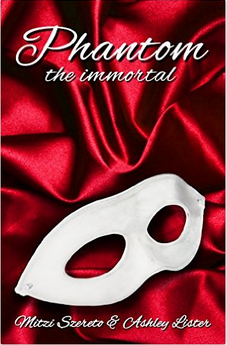 Let the writing happen. A sex scene should blend in naturally, not stick out like the proverbial sore thumb. Get rid of that silly shorthand sex language and terminology and actually create. By that I mean utilize description and incorporate the senses into the scene. Don’t write a play-by-play report of your favourite football team’s winning goal. And don’t suddenly switch to some boys’ locker room style of prose. Write in the same style in which you’ve written the rest of the piece and stop worrying so much. You’re not writing about you—you’re writing about your characters. It’s just a sex scene. And I’ll tell you this for free: it’s no big deal!
Let the writing happen. A sex scene should blend in naturally, not stick out like the proverbial sore thumb. Get rid of that silly shorthand sex language and terminology and actually create. By that I mean utilize description and incorporate the senses into the scene. Don’t write a play-by-play report of your favourite football team’s winning goal. And don’t suddenly switch to some boys’ locker room style of prose. Write in the same style in which you’ve written the rest of the piece and stop worrying so much. You’re not writing about you—you’re writing about your characters. It’s just a sex scene. And I’ll tell you this for free: it’s no big deal!
Mitzi Szereto’s latest book, Phantom: The Immortal, is a collaboration with Ashley Lister and a contemporary erotic sequel that relocates the original character from The Phantom of the Opera to present-day Paris.


February 6, 2016
7 ways to increase your chances of being taken on by a literary agent
This is an extract from an article that first appeared in issue 7 of Publishing Talk Magazine.
What can you do to maximise your chances of having your submission read and being taken on by a literary agent? We asked bestselling agent Andrew Lownie of the Andrew Lownie Literary Agency to share his top 7 tips.

Research agencies to find the right fit. This is very easy to do, not least from looking at agency’s own websites, reference works, The Bookseller etc.
Look at similar books. Look in the acknowledgements pages of books that are comparable to see who was the agent. My agency doesn’t handle poetry, short stories, science fiction, romance, fantasy, women’s fiction, religious so it’s a waste of your and time to send to me.
Personalise your submission. Target it to the right agent and use their name. Show you know what they handle and suggest how your book is similar. Give the impression this is an individual and not blanket approach.
Don’t submit too early. You only have one shot. Make sure your submission is grammatical and polished by having it checked by a freelance editor.
Build your profile. The more Twitter followers you have and the greater your engagement with social media and sites such as Goodreads the better.
Give agents what they ask for. If they want chapter synopses or first three chapters then send that. It shows professionalism and will help the agent properly assess the submission. I personally want a one-page pitch on book, a page on authors and their platform, a page with details on five similar books and how your book is positioned in the market and suggested marketing outlets for book such as organisations, websites and magazines.
Network. Go to where agents gather such as literary and writing festivals, meetings of Society of Authors etc.
Read more advice from Andrew in issue 7 of Publishing Talk Magazine.


February 1, 2016
How to create an on-trend book cover in 5 steps
This article first appeared in issue 7 of Publishing Talk Magazine.
An effective book cover can make the difference between obscurity and bestseller. Sarah Juckes shows you how to create your own.
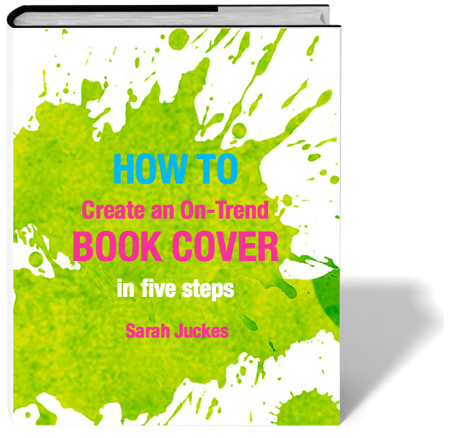
While helping hundreds of authors self-publish books with CompletelyNovel.com, I’ve seen first-hand the difference an effective book cover can make. Using cover components that are currently on-trend in a genre can catapult a new book by an unknown author into the shopping carts of readers.
Here are five tried-and-tested steps to create a professional and current book cover.
1. Identify similar books your readers loved
Before you work on making your book ‘stand out’, you first need to ensure that your readers are going to recognise your book as the genre/type of book they usually enjoy. First of all, identify the primary target readers for your book (Young adults? Crime thriller enthusiasts? Business owners?) and collate a mood board of book covers they might have enjoyed. If you’re not sure – think about the books that inspired you to write.
For example, an author with a travel/sports book might identify her primary target readers as keen runners. By using social reading websites such as Goodreads and even Amazon’s ‘recommended’ function, she can find books that her target readers might have already read and loved. Pinterest is a perfect tool for collating these covers together for Step Two.
2. Pinpoint the key visual signifiers in similar book covers
Once you have a clear idea of what books your reader loves, you can discover the key ‘visual signifiers’ that they will recognise in their favourite covers. For instance, our sports/travel author may find that many books in her genre include a figure of a person running on the cover, with bright colours and a large title. Whereas a crime fiction author might find that a colour-picked photograph and bold, distressed font is currently popular.
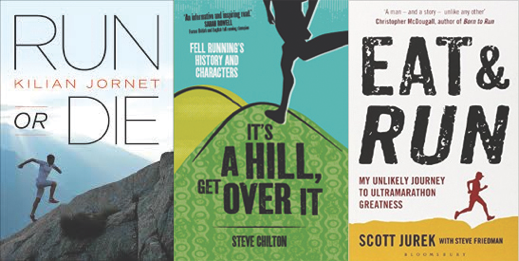 Choose three book covers from your moodboard that have been published in the last year and fill out the table like the one below. Go into as much detail as you can – the more visual signifiers you find, the better!
Choose three book covers from your moodboard that have been published in the last year and fill out the table like the one below. Go into as much detail as you can – the more visual signifiers you find, the better!
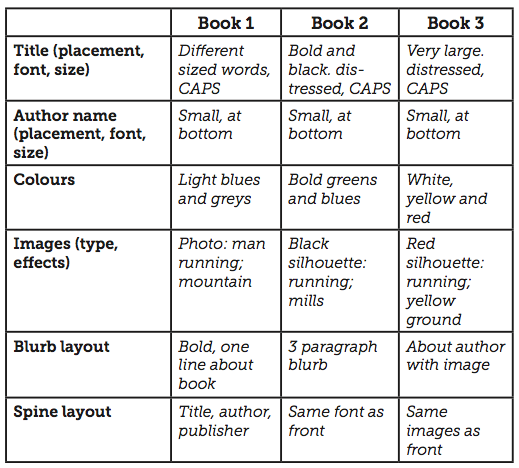 Once you know the cover conventions for your genre, you can use these to create a cover that your readers will recognise, as well as something that will stand out on a shelf.
Once you know the cover conventions for your genre, you can use these to create a cover that your readers will recognise, as well as something that will stand out on a shelf.
Resist the temptation to defy all the conventions of your genre at this stage – this is something you can do after you have a strong reader following behind you.
For now, your aim is to communicate to a reader where your book fits in with their expectations.
3. Draft your cover
It can be really easy to get bogged down in the specifics of creating a cover, so to start with, play about with a few very basic drafts. Take the visual signifiers you identified in the last task and arrange them in a rough outline using a pen and paper. Try a few different arrangements – which one looks best?
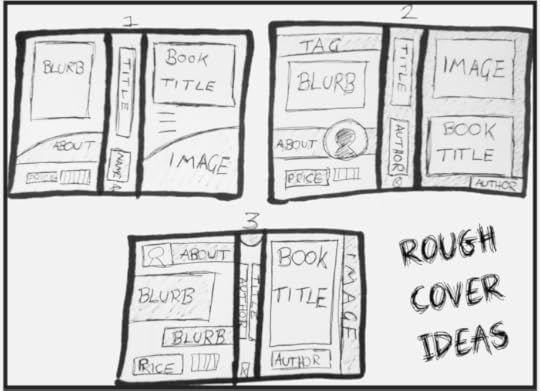
Next, start filling it in with a bit more detail – perhaps using Google Drawings, or Paint (again, don’t get too fixated on perfecting things yet). Choose three different images using photo-finding websites such as iStockPhoto and ShutterStock. Add different colours and shades, as well as different fonts and wording for any taglines and the blurb. This time, get feedback from your target readers via social media and reading groups. Which draft do they like best? Keep playing until you have a sketch of what you’d like your finished cover to look like.
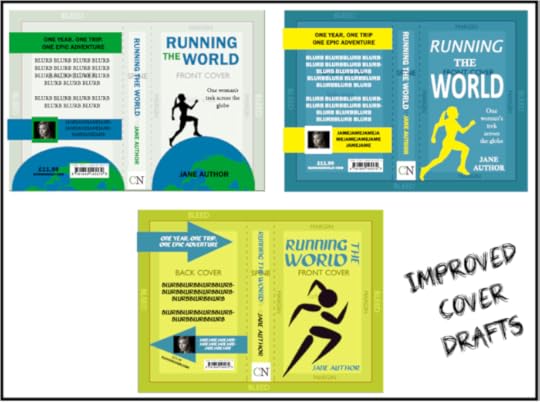
4. Create your cover
My cover creation software of choice is Photoshop, as it has all the tools I need to create a beautiful and precise cover. It is a little expensive though, so this might be where you want to bring in the services of a professional designer, or try using a free version of Photoshop, such as Gimp.
Firstly, create a canvas using the print specifications from your printer. This should include (from left to right) a back cover, a spine and a front cover design on one page (if you are designing a cover for a print book) and a front cover only for an eBook. As CompletelyNovel.com specialises in paperbacks, I’m going to focus on creating a cover template for a print book.
Top 5 Photoshop tools for creating a cover template
Guides – To help you map out your spine and margins.
Rulers – Change these to millimetres to make measuring much easier.
Content aware fill – Wonderful for images that aren’t quite the right shape.
Smart layers – For adding different layer effects.
Google – There’s tonnes of help and tutorials out there if you get stuck.
Getting the images and colours right
 Graphics software will let you choose what’s called a colour profile. For print books you should always select CMYK as this is the standard that printers use and will help ensure your colours come out properly. If you are creating an image that will be only used on a screen, then you can choose the RGB colour profile.
Graphics software will let you choose what’s called a colour profile. For print books you should always select CMYK as this is the standard that printers use and will help ensure your colours come out properly. If you are creating an image that will be only used on a screen, then you can choose the RGB colour profile.
Ensure all the images you are using are large – images for printing need to be at least 300 dpi. Again, all these options are available when you first create your file. You will need to include the following components in your template:
 Spine Width. This will depend on the number of pages in your manuscript and the thickness of paper used. It’s worth getting the exact measurement from your publisher/printer, but a rough calculation you can do for paperbacks is (number of pages) x 0.054 = width in mm.
Spine Width. This will depend on the number of pages in your manuscript and the thickness of paper used. It’s worth getting the exact measurement from your publisher/printer, but a rough calculation you can do for paperbacks is (number of pages) x 0.054 = width in mm.
 Bleed. To ensure your cover doesn’t have any white space along the edges, include a 3mm bleed around the outside. Don’t place anything important in here as it will get cut off by the printer!
Bleed. To ensure your cover doesn’t have any white space along the edges, include a 3mm bleed around the outside. Don’t place anything important in here as it will get cut off by the printer!

Margin. Include a margin between the trim line and any texts and images. This will ensure nothing important gets cut and makes your book look more professional.
 Trim size. This is the size your cover will be when cut by the printers.
Trim size. This is the size your cover will be when cut by the printers.
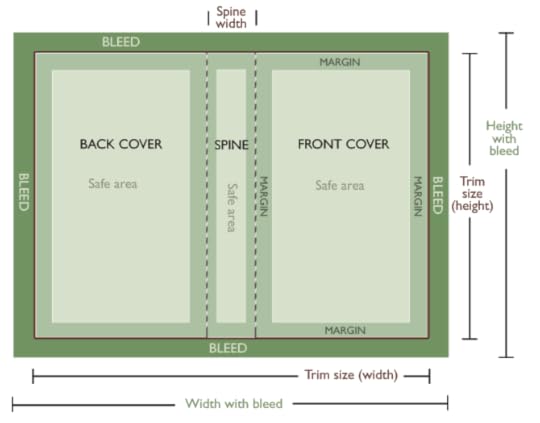
You can also download free templates to work from on CompletelyNovel.
5. Add visual signifiers to your book cover
Once you have your template in place, you can start adding your cover signifiers to the ‘safe area’ inside your template. Don’t forget to make sure all your images and text line up (you can use Photoshop guides to help you); that you have spell-checked your blurb; and added a barcode and price to the back. Also, ensure your spine is the right way around! It should face upwards when the book is back-side down.
Don’t underestimate the time it takes to craft a brilliant blurb. This is one of the most important components of a book cover. I wrote some advice on this for the Alliance of Independent Authors here.
Next steps
Keep a clearly-labelled PSD file with your layers on somewhere safe, in case you need to come back to it later. You should also test your cover with your readers – what do they think?
Remember – what is ‘on-trend’ is always changing, so spend time in bookshops and keep reading similar books to yours to stay on top of what is current in your genre. In a few years time, you might need to follow these steps again.
You can find downloadable cover templates, further advice and more information on print book creation and publishing over at CompletelyNovel.com. CompletelyNovel is a professional self-publishing platform specialising in high-quality print on demand publishing. Find out more here.


January 27, 2016
Top 3 self-publishing mistakes – and how to avoid them
This article first appeared in issue 7 of Publishing Talk Magazine.
Self-published authors have a huge range of options these days. But with freedom comes responsibility, says Leila Dewji.

There are more choices than ever for self-publishing authors – from which retailers to sell through to which type of paper to print on. But with so many options now available, the burden of getting it right is massive. In a traditional publishing company each team is responsible for just one element – e.g. the design team is in charge of the jacket – but you, as a self-publishing author, have to take on absolute responsibility for the whole thing. I mean everything.
Self-publishing gives you great freedom but, with a barrier-less market, you are also free to make mistakes. There are no safety nets to protect you and no senior managers you can turn to for advice in your team of just one. So, if you haven’t done it before or don’t know people who have, then you could find yourself in a daunting (albeit exiting) position.
It’s understandable, therefore, that despite the raging success stories from self-published bestsellers such as E.L. James and Rachel Abbott, a lot of authors don’t quite get it right (just take a look at the Kindle Cover Disasters blog). If I were to set up a project in an industry I had no working experience of, no doubt I would make mistakes too. Here are the top three mistakes to avoid:
1. Not Understanding your readers
I went to a seminar recently where a top Guardian journalist said ‘stalk your readers’. Now, while this isn’t to be taken literally, you need to think like a big company would when launching a new product – you need to do some market research and get inside the minds of your future readers:
Which demographic does your genre most appeal to (e.g. female commuters between the ages of 20-30)?
Which format do your readers prefer to read?
How much are they prepared to pay for their next read?
Where/when are they most likely to buy their next book?
Where do they get their recommendations from?
Which bloggers are most influential for your type of book?
Who are the top Amazon reviewers for your genre?
The best way to collect this information is to be a reader yourself. You will probably have written in a genre you enjoy reading, so ensure you make time to read the latest ‘big’ books in your subject chart. Have a look at the Amazon reviews, see what bloggers are saying about those books etc. If you have friends and family that are regular readers of your genre then quiz them about their buying habits.
2. Rushing
This one can, unfortunately, be fatal. This is the disease that can reach into and destroy any part of the publishing process. Hugh Howey, a bestselling self-published author said: ‘the biggest barrier to releasing quality material is probably impatience.’ Because authors are generally relieved and delighted to have finished writing their manuscript, they can be impatient to see it in print and not realise the time it takes to complete all other stages of the process properly. A trade publisher will typically take 12-18 months to publish a title. While self-publishing is a lot faster and more dynamic, there are so many decisions to be made (and opportunities to make really bad decisions) that you need time to prepare, do your research and consider each option properly. Just because a certain option was the best for another author, doesn’t necessarily mean it will be for you.
Unless you enlist the services of a professional, there is no one to tell you to rework a chapter or cover design, so don’t be your own worst enemy here. Having spent months of hard work and made sacrifices to get your manuscript finished, give yourself time to do all the other elements properly too. The publishing process is not linear. You need to plan ahead and set timelines for each element, particularly with marketing and publicity.
3. Cutting corners
This can be as fatal as rushing. Again, you really need to think like a trade publisher here. The top publishing companies have to keep their shareholders happy. That means that they need to efficiently make the most money from what they produce. Of course they are looking at their bottom line, just like any self-publishing author. However, they know that to achieve sales they cannot cut corners and produce a sub-standard product. The truth is, their readers are not at all loyal and will simply switch to buying books from a competitor. This could happen to you too. You need to make sure that your book holds up to the competition in every way: the content, the design, the production… everything.
When in doubt with any element of the self-publishing process seek professional advice (some of which is freely available), join a self-publishing community or ask your potential readers what they prefer.


Top 3 self-publishing mistakes to avoid
This article first appeared in issue 7 of Publishing Talk Magazine.
Self-published authors have a huge range of options these days. But with freedom comes responsibility, says Leila Dewji.

There are more choices than ever for self-publishing authors – from which retailers to sell through to which type of paper to print on. But with so many options now available, the burden of getting it right is massive. In a traditional publishing company each team is responsible for just one element – e.g. the design team is in charge of the jacket – but you, as a self-publishing author, have to take on absolute responsibility for the whole thing. I mean everything.
Self-publishing gives you great freedom but, with a barrier-less market, you are also free to make mistakes. There are no safety nets to protect you and no senior managers you can turn to for advice in your team of just one. So, if you haven’t done it before or don’t know people who have, then you could find yourself in a daunting (albeit exiting) position.
It’s understandable, therefore, that despite the raging success stories from self-published bestsellers such as E.L. James and Rachel Abbott, a lot of authors don’t quite get it right (just take a look at the Kindle Cover Disasters blog). If I were to set up a project in an industry I had no working experience of, no doubt I would make mistakes too. Here are the top three mistakes to avoid:
1. Not Understanding your readers
I went to a seminar recently where a top Guardian journalist said ‘stalk your readers’. Now, while this isn’t to be taken literally, you need to think like a big company would when launching a new product – you need to do some market research and get inside the minds of your future readers:
Which demographic does your genre most appeal to (e.g. female commuters between the ages of 20-30)?
Which format do your readers prefer to read?
How much are they prepared to pay for their next read?
Where/when are they most likely to buy their next book?
Where do they get their recommendations from?
Which bloggers are most influential for your type of book?
Who are the top Amazon reviewers for your genre?
The best way to collect this information is to be a reader yourself. You will probably have written in a genre you enjoy reading, so ensure you make time to read the latest ‘big’ books in your subject chart. Have a look at the Amazon reviews, see what bloggers are saying about those books etc. If you have friends and family that are regular readers of your genre then quiz them about their buying habits.
2. Rushing
This one can, unfortunately, be fatal. This is the disease that can reach into and destroy any part of the publishing process. Hugh Howey, a bestselling self-published author said: ‘the biggest barrier to releasing quality material is probably impatience.’ Because authors are generally relieved and delighted to have finished writing their manuscript, they can be impatient to see it in print and not realise the time it takes to complete all other stages of the process properly. A trade publisher will typically take 12-18 months to publish a title. While self-publishing is a lot faster and more dynamic, there are so many decisions to be made (and opportunities to make really bad decisions) that you need time to prepare, do your research and consider each option properly. Just because a certain option was the best for another author, doesn’t necessarily mean it will be for you.
Unless you enlist the services of a professional, there is no one to tell you to rework a chapter or cover design, so don’t be your own worst enemy here. Having spent months of hard work and made sacrifices to get your manuscript finished, give yourself time to do all the other elements properly too. The publishing process is not linear. You need to plan ahead and set timelines for each element, particularly with marketing and publicity.
3. Cutting corners
This can be as fatal as rushing. Again, you really need to think like a trade publisher here. The top publishing companies have to keep their shareholders happy. That means that they need to efficiently make the most money from what they produce. Of course they are looking at their bottom line, just like any self-publishing author. However, they know that to achieve sales they cannot cut corners and produce a sub-standard product. The truth is, their readers are not at all loyal and will simply switch to buying books from a competitor. This could happen to you too. You need to make sure that your book holds up to the competition in every way: the content, the design, the production… everything.
When in doubt with any element of the self-publishing process seek professional advice (some of which is freely available), join a self-publishing community or ask your potential readers what they prefer.





